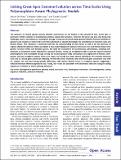Files in this item
Linking great apes genome evolution across time scales using polymorphism-aware phylogenetic models
Item metadata
| dc.contributor.author | De Maio, Nicola | |
| dc.contributor.author | Schlötterer, Christian | |
| dc.contributor.author | Kosiol, Carolin | |
| dc.date.accessioned | 2017-02-09T14:30:40Z | |
| dc.date.available | 2017-02-09T14:30:40Z | |
| dc.date.issued | 2013-10 | |
| dc.identifier | 249098788 | |
| dc.identifier | 11e983cf-c17c-489c-a7b6-8df17af9fb00 | |
| dc.identifier | 23906727 | |
| dc.identifier | 84888597013 | |
| dc.identifier.citation | De Maio , N , Schlötterer , C & Kosiol , C 2013 , ' Linking great apes genome evolution across time scales using polymorphism-aware phylogenetic models ' , Molecular Biology and Evolution , vol. 30 , no. 10 , pp. 2249-62 . https://doi.org/10.1093/molbev/mst131 | en |
| dc.identifier.issn | 0737-4038 | |
| dc.identifier.other | PubMedCentral: PMC3773373 | |
| dc.identifier.uri | https://hdl.handle.net/10023/10261 | |
| dc.description.abstract | The genomes of related species contain valuable information on the history of the considered taxa. Great apes in particular exhibit variation of evolutionary patterns along their genomes. However, the great ape data also bring new challenges, such as the presence of incomplete lineage sorting and ancestral shared polymorphisms. Previous methods for genome-scale analysis are restricted to very few individuals or cannot disentangle the contribution of mutation rates and fixation biases. This represents a limitation both for the understanding of these forces as well as for the detection of regions affected by selection. Here, we present a new model designed to estimate mutation rates and fixation biases from genetic variation within and between species. We relax the assumption of instantaneous substitutions, modeling substitutions as mutational events followed by a gradual fixation. Hence, we straightforwardly account for shared ancestral polymorphisms and incomplete lineage sorting. We analyze genome-wide synonymous site alignments of human, chimpanzee, and two orangutan species. From each taxon, we include data from several individuals. We estimate mutation rates and GC-biased gene conversion intensity. We find that both mutation rates and biased gene conversion vary with GC content. We also find lineage-specific differences, with weaker fixation biases in orangutan species, suggesting a reduced historical effective population size. Finally, our results are consistent with directional selection acting on coding sequences in relation to exonic splicing enhancers. | |
| dc.format.extent | 14 | |
| dc.format.extent | 673347 | |
| dc.language.iso | eng | |
| dc.relation.ispartof | Molecular Biology and Evolution | en |
| dc.subject | Phylogenetics-population genetics model | en |
| dc.subject | Mutation rates | en |
| dc.subject | Biased gene conversion | en |
| dc.subject | Rate heterogeneity | en |
| dc.subject | Coding sequence evolution | en |
| dc.subject | Primates evolution | en |
| dc.subject | QH301 Biology | en |
| dc.subject | QH426 Genetics | en |
| dc.subject.lcc | QH301 | en |
| dc.subject.lcc | QH426 | en |
| dc.title | Linking great apes genome evolution across time scales using polymorphism-aware phylogenetic models | en |
| dc.type | Journal article | en |
| dc.contributor.institution | University of St Andrews. School of Biology | en |
| dc.contributor.institution | University of St Andrews. Centre for Biological Diversity | en |
| dc.identifier.doi | https://doi.org/10.1093/molbev/mst131 | |
| dc.description.status | Peer reviewed | en |
This item appears in the following Collection(s)
Items in the St Andrews Research Repository are protected by copyright, with all rights reserved, unless otherwise indicated.

